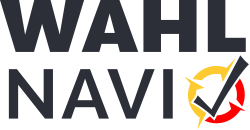Choice sat nav
|
|
|
|---|---|
| https://www.wahlnavi.de/ |
The Election Navi is an interactive online application developed by political scientists and used before elections. It asks users about their political attitudes to topics relevant to elections and, on the basis of the user answers, calculates how close these particular parties are - and how they rate their candidates.
The Vote Compass was already used by millions of people worldwide before elections. It is operated by Vox Pop Labs, a company committed to social goals. For the Vote Compass, Vox Pop Labs collaborates with local news organizations, including the Wall Street Journal, Vox Media, the Canadian Broadcasting Corporation, the Australian Broadcasting Corporation, Television New Zealand, France 24 - and now under the name Wahl-Navi with the Mediengruppe RTL (RTL, ntv, RTL2) in Germany .
The Wahl-Navi went online for the first time in Germany on August 25, 2017 - in cooperation with Mediengruppe RTL. After the first week, the number of users has already reached over a million.
Emergence
The Elective Navi was developed by Clifton van der Linden, a PhD student at the Institute of Political Science at the University of Toronto. In December 2012 it was carried out by van der Linden together with a team of political and social scientists and statisticians from his company Vox Pop Labs. Although the Wahl-Navi was inspired by European election recommendation tools, van der Linden strictly rejects this designation. The Vote Compass “was not developed to calculate all possible variables that influence a voting decision. His results should therefore not be understood as an election recommendation. "
methodology
The users answer a series of questions using the so-called Likert scale. The questions are selected in such a way that they play a role in as many of the major parties' election programs as possible and allow the best possible differentiation between the parties. The questions for the dial-up navigation system were selected in collaboration with German political scientists.
Based on public statements by the parties and their candidates (e.g. party programs, bills, official websites, speeches, press releases, statements in the Bundestag etc.), the respective parties were also assigned answers on the same Likert scale to each question. In a second step, these assignments were mirrored with the parties and discussed critically with them. A whole series of algorithms calculate the general proximity of the user to each represented party after each use.
Individual evidence
- ↑ Bundestag election 2017: Online questionnaire election navigation system helps you navigate the jungle of programs , RTL Next. August 30, 2017. Accessed August 31, 2017.
- ↑ Top start for the dial-up navigation system - one million users after the first week , Mediengruppe RTL Deutschland. 1st September 2017.
- ^ Vote Turnout: Thinking Outside the (Ballot) Box , The Mark News. December 14, 2011. Retrieved December 22, 2011.
- ↑ Method report Wahl-Navi . Vox Pop Labs. Retrieved August 28, 2017.
- ^ Clifton van der Linden and Yannick Dufresne: The curse of dimensionality in Voting Advice Applications: reliability and validity in algorithm design . Pp. 9-30. 2017. Retrieved August 28, 2017.
